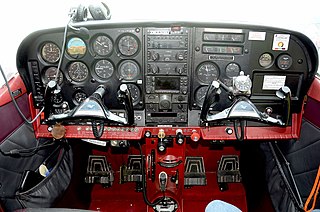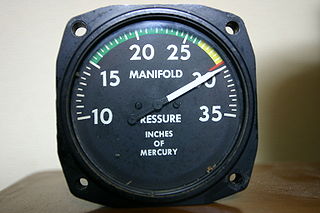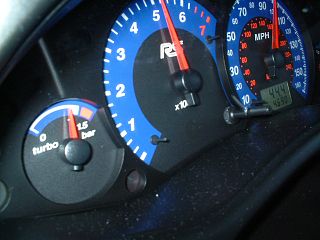
A turbocharger, formally a turbosupercharger and colloquially known as turbo, is a turbine-driven, forced induction device that increases an internal combustion engine's power output by forcing extra compressed air into the combustion chamber. This improvement over a naturally aspirated engine's power output is because the compressor can force more air—and proportionately more fuel—into the combustion chamber than atmospheric pressure alone.

In engineering, the Miller cycle is a thermodynamic cycle used in a type of internal combustion engine. The Miller cycle was patented by Ralph Miller, an American engineer, U.S. Patent 2,817,322 dated Dec 24, 1957. The engine may be two- or four-stroke and may be run on diesel fuel, gases, or dual fuel.

Aircraft engine controls provide a means for the pilot to control and monitor the operation of the aircraft's powerplant. This article describes controls used with a basic internal-combustion engine driving a propeller. Some optional or more advanced configurations are described at the end of the article. Jet turbine engines use different operating principles and have their own sets of controls and sensors.
The active valve control system (AVCS) is an automobile variable valve timing technology used by Subaru. It varies the timing of the valves by using hydraulic oil pressure to rotate the camshaft, known as "phasing", in order to provide optimal valve timing for engine load conditions. The system is closed loop using the camshaft sensors, crankshaft sensors, air flow meter, throttle position as well as oxygen sensors and/or Air-Fuel ratio sensors in order to calculate engine load. The ECU is programmed to operate control valves that adjust the delivery of the hydraulic pressure in order to move the camshaft into the position that will provide the engine with the best performance while meeting emissions standards.

A blowoff valve is a pressure release system present in most turbocharged engines. Blowoff valves are used to reduce pressure in the intake system as the throttle is closed, thus preventing compressor surge.
Toyota Variable Induction System, or T-VIS, is a variable intake system designed by Toyota to improve the low-end performance of multi-valve engines.

Automatic Performance Control (APC) was the first engine knock and boost control system. The APC was invented by Per Gillbrand at the Swedish car maker SAAB. U.S. Patent 4,372,119
A wastegate is a valve that controls the flow of exhaust gases to the turbine wheel in a turbocharged engine system.
Manifold vacuum, or engine vacuum in an internal combustion engine is the difference in air pressure between the engine's intake manifold and Earth's atmosphere.

The manifold absolute pressure sensor is one of the sensors used in an internal combustion engine's electronic control system.
The anti-lag system (ALS) is a method of reducing turbo lag or effective compression used on turbocharged engines to minimize turbo lag on racing or performance cars. It works by delaying the ignition timing and adding extra fuel to balance an inherent loss in combustion efficiency with increased pressure at the charging side of the turbo. This is achieved as an excess amount of fuel/air mixture escapes through the exhaust valves and combusts in the hot exhaust manifold spooling the turbocharger creating higher usable pressure.

An engine control unit (ECU), also commonly called an engine control module (ECM), is a type of electronic control unit that controls a series of actuators on an internal combustion engine to ensure optimal engine performance. It does this by reading values from a multitude of sensors within the engine bay, interpreting the data using multidimensional performance maps, and adjusting the engine actuators. Before ECUs, air–fuel mixture, ignition timing, and idle speed were mechanically set and dynamically controlled by mechanical and pneumatic means.
Twincharger refers to a compound forced induction system used on some piston-type internal combustion engines. It is a combination of an exhaust-driven turbocharger and a mechanically driven supercharger, each mitigating the weaknesses of the other. A mechanically driven supercharger offers exceptional response and low-rpm performance as it does not rely on pressurization of the exhaust manifold. A turbocharger sized to move a large volume of air tends to respond slowly to throttle input while a smaller, faster-responding turbo may fail to deliver sufficient volume through an engine's upper RPM range. The unacceptable lag time endemic to a large turbocharger is effectively neutralized when combined with a supercharger which tends to generate substantial boost pressure much faster in response to throttle input. The end result being a zero-lag powerband with high torque at lower engine speeds and increased power at the upper end. Twincharging is therefore desirable for small-displacement motors, especially those with a large operating rpm, since they can take advantage of an artificially broad torque band over a large speed range.

A boost gauge is a pressure gauge that indicates manifold air pressure or turbocharger or supercharger boost pressure in an internal combustion engine. They are commonly mounted on the dashboard, on the driver's side pillar, or in a radio slot.
Twin-turbo refers to an engine in which two turbochargers compress the intake fuel/air mixture. The most common layout features two identical or mirrored turbochargers in parallel, each processing half of a V engine's produced exhaust through independent piping. The two turbochargers can either be identical or different sizes.
A throttle is the mechanism by which fluid flow is managed by constriction or obstruction.

Electronic Diesel Control is a diesel engine fuel injection control system for the precise metering and delivery of fuel into the combustion chamber of modern diesel engines used in trucks and cars.

MultiAir is a hydraulically-actuated variable valve timing and variable valve lift engine technology enabling "cylinder by cylinder, stroke by stroke" control of intake air directly via a gasoline engine's inlet valves. Developed by Fiat Powertrain Technologies, the technology bypasses a primary engine inefficiency: pumping losses caused by restriction of the intake passage by the throttle plate, used to regulate air feeding the cylinders.
An electric supercharger is a specific type of supercharger for internal combustion engines that uses an electrically powered forced-air system that contains an electric motor to pressurize the intake air. By pressurizing the air available to the engine intake system, the air becomes more dense, and is matched with more fuel, producing the increased horsepower to the wheels.











